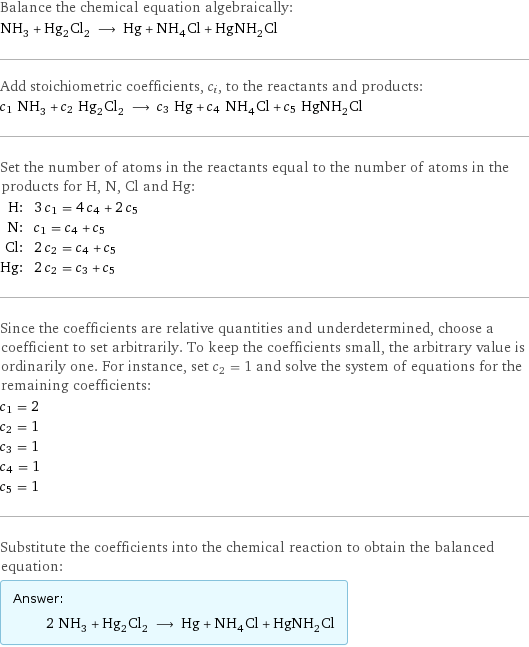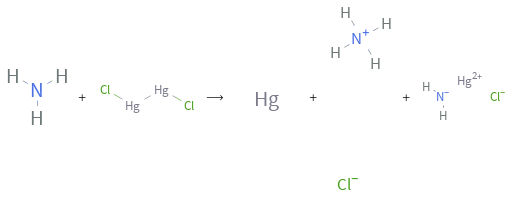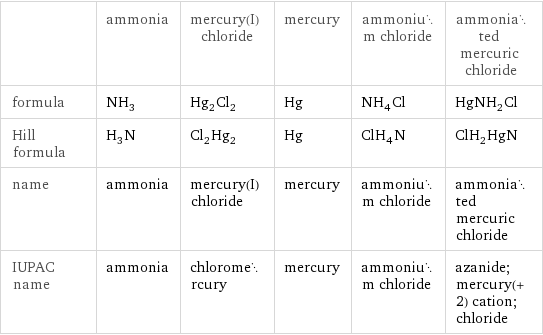Input interpretation

NH_3 (ammonia) + Hg_2Cl_2 (mercury(I) chloride) ⟶ Hg (mercury) + NH_4Cl (ammonium chloride) + HgNH_2Cl (ammoniated mercuric chloride)
Balanced equation

Balance the chemical equation algebraically: NH_3 + Hg_2Cl_2 ⟶ Hg + NH_4Cl + HgNH_2Cl Add stoichiometric coefficients, c_i, to the reactants and products: c_1 NH_3 + c_2 Hg_2Cl_2 ⟶ c_3 Hg + c_4 NH_4Cl + c_5 HgNH_2Cl Set the number of atoms in the reactants equal to the number of atoms in the products for H, N, Cl and Hg: H: | 3 c_1 = 4 c_4 + 2 c_5 N: | c_1 = c_4 + c_5 Cl: | 2 c_2 = c_4 + c_5 Hg: | 2 c_2 = c_3 + c_5 Since the coefficients are relative quantities and underdetermined, choose a coefficient to set arbitrarily. To keep the coefficients small, the arbitrary value is ordinarily one. For instance, set c_2 = 1 and solve the system of equations for the remaining coefficients: c_1 = 2 c_2 = 1 c_3 = 1 c_4 = 1 c_5 = 1 Substitute the coefficients into the chemical reaction to obtain the balanced equation: Answer: | | 2 NH_3 + Hg_2Cl_2 ⟶ Hg + NH_4Cl + HgNH_2Cl
Structures

+ ⟶ + +
Names

ammonia + mercury(I) chloride ⟶ mercury + ammonium chloride + ammoniated mercuric chloride
Equilibrium constant
![Construct the equilibrium constant, K, expression for: NH_3 + Hg_2Cl_2 ⟶ Hg + NH_4Cl + HgNH_2Cl Plan: • Balance the chemical equation. • Determine the stoichiometric numbers. • Assemble the activity expression for each chemical species. • Use the activity expressions to build the equilibrium constant expression. Write the balanced chemical equation: 2 NH_3 + Hg_2Cl_2 ⟶ Hg + NH_4Cl + HgNH_2Cl Assign stoichiometric numbers, ν_i, using the stoichiometric coefficients, c_i, from the balanced chemical equation in the following manner: ν_i = -c_i for reactants and ν_i = c_i for products: chemical species | c_i | ν_i NH_3 | 2 | -2 Hg_2Cl_2 | 1 | -1 Hg | 1 | 1 NH_4Cl | 1 | 1 HgNH_2Cl | 1 | 1 Assemble the activity expressions accounting for the state of matter and ν_i: chemical species | c_i | ν_i | activity expression NH_3 | 2 | -2 | ([NH3])^(-2) Hg_2Cl_2 | 1 | -1 | ([Hg2Cl2])^(-1) Hg | 1 | 1 | [Hg] NH_4Cl | 1 | 1 | [NH4Cl] HgNH_2Cl | 1 | 1 | [HgNH2Cl] The equilibrium constant symbol in the concentration basis is: K_c Mulitply the activity expressions to arrive at the K_c expression: Answer: | | K_c = ([NH3])^(-2) ([Hg2Cl2])^(-1) [Hg] [NH4Cl] [HgNH2Cl] = ([Hg] [NH4Cl] [HgNH2Cl])/(([NH3])^2 [Hg2Cl2])](../image_source/8e8684af47688d627b1f211cd912ebbd.png)
Construct the equilibrium constant, K, expression for: NH_3 + Hg_2Cl_2 ⟶ Hg + NH_4Cl + HgNH_2Cl Plan: • Balance the chemical equation. • Determine the stoichiometric numbers. • Assemble the activity expression for each chemical species. • Use the activity expressions to build the equilibrium constant expression. Write the balanced chemical equation: 2 NH_3 + Hg_2Cl_2 ⟶ Hg + NH_4Cl + HgNH_2Cl Assign stoichiometric numbers, ν_i, using the stoichiometric coefficients, c_i, from the balanced chemical equation in the following manner: ν_i = -c_i for reactants and ν_i = c_i for products: chemical species | c_i | ν_i NH_3 | 2 | -2 Hg_2Cl_2 | 1 | -1 Hg | 1 | 1 NH_4Cl | 1 | 1 HgNH_2Cl | 1 | 1 Assemble the activity expressions accounting for the state of matter and ν_i: chemical species | c_i | ν_i | activity expression NH_3 | 2 | -2 | ([NH3])^(-2) Hg_2Cl_2 | 1 | -1 | ([Hg2Cl2])^(-1) Hg | 1 | 1 | [Hg] NH_4Cl | 1 | 1 | [NH4Cl] HgNH_2Cl | 1 | 1 | [HgNH2Cl] The equilibrium constant symbol in the concentration basis is: K_c Mulitply the activity expressions to arrive at the K_c expression: Answer: | | K_c = ([NH3])^(-2) ([Hg2Cl2])^(-1) [Hg] [NH4Cl] [HgNH2Cl] = ([Hg] [NH4Cl] [HgNH2Cl])/(([NH3])^2 [Hg2Cl2])
Rate of reaction
![Construct the rate of reaction expression for: NH_3 + Hg_2Cl_2 ⟶ Hg + NH_4Cl + HgNH_2Cl Plan: • Balance the chemical equation. • Determine the stoichiometric numbers. • Assemble the rate term for each chemical species. • Write the rate of reaction expression. Write the balanced chemical equation: 2 NH_3 + Hg_2Cl_2 ⟶ Hg + NH_4Cl + HgNH_2Cl Assign stoichiometric numbers, ν_i, using the stoichiometric coefficients, c_i, from the balanced chemical equation in the following manner: ν_i = -c_i for reactants and ν_i = c_i for products: chemical species | c_i | ν_i NH_3 | 2 | -2 Hg_2Cl_2 | 1 | -1 Hg | 1 | 1 NH_4Cl | 1 | 1 HgNH_2Cl | 1 | 1 The rate term for each chemical species, B_i, is 1/ν_i(Δ[B_i])/(Δt) where [B_i] is the amount concentration and t is time: chemical species | c_i | ν_i | rate term NH_3 | 2 | -2 | -1/2 (Δ[NH3])/(Δt) Hg_2Cl_2 | 1 | -1 | -(Δ[Hg2Cl2])/(Δt) Hg | 1 | 1 | (Δ[Hg])/(Δt) NH_4Cl | 1 | 1 | (Δ[NH4Cl])/(Δt) HgNH_2Cl | 1 | 1 | (Δ[HgNH2Cl])/(Δt) (for infinitesimal rate of change, replace Δ with d) Set the rate terms equal to each other to arrive at the rate expression: Answer: | | rate = -1/2 (Δ[NH3])/(Δt) = -(Δ[Hg2Cl2])/(Δt) = (Δ[Hg])/(Δt) = (Δ[NH4Cl])/(Δt) = (Δ[HgNH2Cl])/(Δt) (assuming constant volume and no accumulation of intermediates or side products)](../image_source/e3fc719997fbde46aef7f4013f72a98c.png)
Construct the rate of reaction expression for: NH_3 + Hg_2Cl_2 ⟶ Hg + NH_4Cl + HgNH_2Cl Plan: • Balance the chemical equation. • Determine the stoichiometric numbers. • Assemble the rate term for each chemical species. • Write the rate of reaction expression. Write the balanced chemical equation: 2 NH_3 + Hg_2Cl_2 ⟶ Hg + NH_4Cl + HgNH_2Cl Assign stoichiometric numbers, ν_i, using the stoichiometric coefficients, c_i, from the balanced chemical equation in the following manner: ν_i = -c_i for reactants and ν_i = c_i for products: chemical species | c_i | ν_i NH_3 | 2 | -2 Hg_2Cl_2 | 1 | -1 Hg | 1 | 1 NH_4Cl | 1 | 1 HgNH_2Cl | 1 | 1 The rate term for each chemical species, B_i, is 1/ν_i(Δ[B_i])/(Δt) where [B_i] is the amount concentration and t is time: chemical species | c_i | ν_i | rate term NH_3 | 2 | -2 | -1/2 (Δ[NH3])/(Δt) Hg_2Cl_2 | 1 | -1 | -(Δ[Hg2Cl2])/(Δt) Hg | 1 | 1 | (Δ[Hg])/(Δt) NH_4Cl | 1 | 1 | (Δ[NH4Cl])/(Δt) HgNH_2Cl | 1 | 1 | (Δ[HgNH2Cl])/(Δt) (for infinitesimal rate of change, replace Δ with d) Set the rate terms equal to each other to arrive at the rate expression: Answer: | | rate = -1/2 (Δ[NH3])/(Δt) = -(Δ[Hg2Cl2])/(Δt) = (Δ[Hg])/(Δt) = (Δ[NH4Cl])/(Δt) = (Δ[HgNH2Cl])/(Δt) (assuming constant volume and no accumulation of intermediates or side products)
Chemical names and formulas

| ammonia | mercury(I) chloride | mercury | ammonium chloride | ammoniated mercuric chloride formula | NH_3 | Hg_2Cl_2 | Hg | NH_4Cl | HgNH_2Cl Hill formula | H_3N | Cl_2Hg_2 | Hg | ClH_4N | ClH_2HgN name | ammonia | mercury(I) chloride | mercury | ammonium chloride | ammoniated mercuric chloride IUPAC name | ammonia | chloromercury | mercury | ammonium chloride | azanide; mercury(+2) cation; chloride
Substance properties

| ammonia | mercury(I) chloride | mercury | ammonium chloride | ammoniated mercuric chloride molar mass | 17.031 g/mol | 472.08 g/mol | 200.592 g/mol | 53.49 g/mol | 252.06 g/mol phase | gas (at STP) | solid (at STP) | liquid (at STP) | solid (at STP) | melting point | -77.73 °C | 525 °C | -38.87 °C | 340 °C | boiling point | -33.33 °C | 383 °C | 356.6 °C | | density | 6.96×10^-4 g/cm^3 (at 25 °C) | 7.16 g/cm^3 | 13.534 g/cm^3 | 1.5256 g/cm^3 | 5.7 g/cm^3 solubility in water | | insoluble | slightly soluble | soluble | insoluble surface tension | 0.0234 N/m | | 0.47 N/m | | dynamic viscosity | 1.009×10^-5 Pa s (at 25 °C) | | 0.001526 Pa s (at 25 °C) | | odor | | | odorless | |
Units
